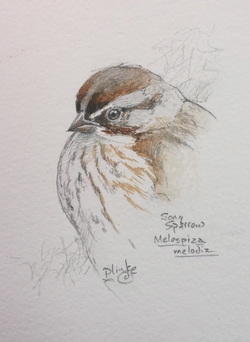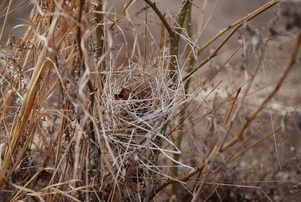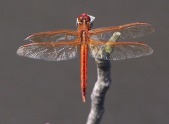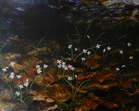| Kurt Plinke, Artist and Naturalist |
Between the Waters
life, Art and The Nature of things Between the Atlantic and the Chesapeake
A Little Brown Bird in the Weeds... the subject of January's watercolor workshop at Sewell Mills.In the tangle of brush, trees and vines between the studio and the river the small brown birds have made themselves at home again for the winter. White-throated Sparrows, Juncos, Fox Sparrows, Tree Sparrows, Field Sparrows, Swamp Sparrows, Chipping Sparrows and Song Sparrows all compete to see who can make the most commotion as they rustle through dry leaves, looking for seeds and small cold insects. I look for them as the leaves drop, but now that Winter is here and the cold nights drive us indoors, little packs of sparrows become more and more noticeable.  Of these little brown bundles of sparrow energy, I think my favorite is the Song Sparrow. This dapper little bird is gorgeous shades of burnt sienna, sepia and gray. His white breast and flanks are heavily streaked with dark jagged lines, forming a dark blot on the middle of his breast. His cap is a mix of reddish-brown and gray, and his face sports a distinctive set of light and dark stripes. Song Sparrows were not named for their jaunty little set of feathers, however. The name, Song Sparrow, is more reflective of their distinctive call, a warbling series of variable notes that almost always begin with a few regularly-spaced single notes.  Song sparrows are not like many other sparrows, who only visit the Eastern Shore during the cold winter months. Song Sparrows call the shore home year-round, and I often find their nests in brushy areas along the edges of farm fields across the county. Usually I notice their nests after the leaves have fallen and the landscapes turn gray and brown, like the Song Sparrows themselves. Their nests are mainly woven grasses, loosely constructed and about nose high off the ground in a twiggy joining of small branches. At the feeders, Song Sparrows are not the most numerous of little birds. White-throats and Juncos outnumber Song Sparrows at least ten to one. This makes me like Song Sparrows even more. Usually one or two of them will show up at the feeders at any one time. Active, these little streaked birds stand out among the other ground birds, who generally tend to move more deliberately. These are the birds we'll be painting during our January watercolor workshop at the studio. We won't be painting a feeder or a tangled bunch of grasses, just a simple study of a Song Sparrow tightly gripping an interesting Winter seed head. If you've never painted a small bird with watercolors, this workshop would be a great place to start. The markings on this little guy will add just enough challenge to keep anyone interested, but the painting will be simple enough to make success all but guaranteed. If you'd like to sign up for this workshop, check out the workshops and classes page of this website. But attend the workshop or not, look for Song Sparrows every time you hear the leaves rustle this time of year.
0 Comments
|
What's News?Kurt Plinke: About Life, Art and the Nature of Things on the Eastern ShoreI write about things I've noticed, places I've been, plans I've made and paintings I've finished or am thinking about. Archives
February 2020
See recent naturalist observations I have posted on iNaturalist:
|
|
Sewell Mills Studio & Gallery
14210 Draper's Mill Road Greensboro, MD 21639 (410) 200-1743 [email protected] |
Rights to all images on this website, created by Kurt Plinke, remain the property of Kurt Plinke. Copying or use of these images is permissible only following written permission from Kurt Plinke. To use images for any purpose, contact [email protected] for permission.


